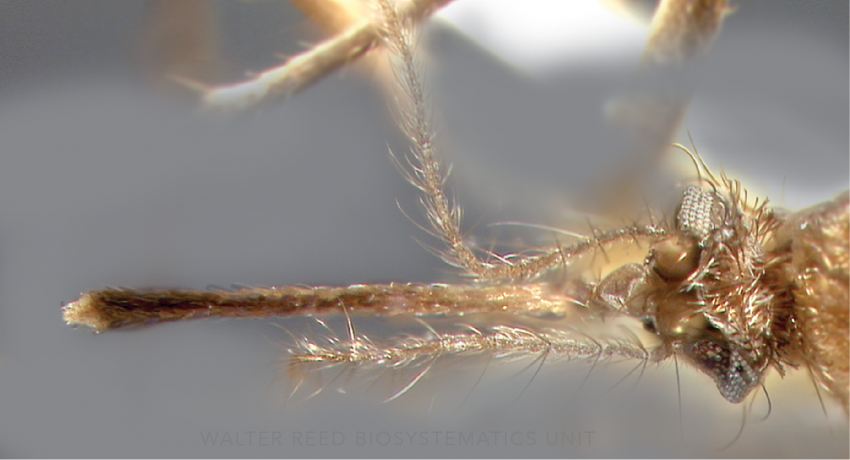NEOTROPICAL REGION
Etymology: not stated [for bone (L)]
Culex ocossa is the nominotypical member of the Ocossa Group, which comprises only Cx. ocossa and the essentially isomorphic species Cx. panocossa Dyar & Knab. Adult females can be differentiated on characters of the cibarial armature—Cx. ocossa has 31 or 32 cibarial teeth, while Cx. panocossa typically has 24 or 25.
Type locality: Georgetown, British Guiana [Guyana]
Type depository: U.S. National Museum, Washington, D.C., United States (USNM)
DIAGNOSTIC CHARACTERS (Click photos to view; mouse over and click large photo to zoom in.)
ADULT (not illustrated): Head: Erect forked scales on vertex all dark. Thorax: Scutum with yellowish integument, with several dark spots; pleural integument yellowish with or without dark spot. Abdomen: Terga with basolateral patches of white scales. Head: Vertex narrow scales dark, whiteish laterally. Leg: Ta-III1–5 all dark.
LARVA (not illustrated): Head: Area between the two seta 1-C concave; seta 2-C present, medial to 1-C; seta 5-C long, with 5–7 aciculate branches. Terminal segments: Comb with 13–25 short comb scales interspersed with 4–6 large spine-like scales; seta 1-S with 6 posterior and 2 anterior pairs of tufts.
TAXONOMIC KEYS
None
![]()
WRBU – Culex (Mel.) - Neotropical Region – Larva
Exemplar DNA sequences
None available
BIONOMICS
Immatures
Immatures of Cx. ocossa are often found in open sunlit or partially shaded freshwater groundwater sites—rivers, lakes, and swamp margins—in forested areas that have muddy bottoms and abundant floating vegetation, such as Pistia, Eichhornia, Salvinia, Azolla. In peri-urban environs, larvae have been collected in artificial lakes, in cement lined pools, and in roadside ditches near cacao plantations.
Adults
In southern Brazil, female Cx. ocossa will enter homes to feed on people. Peak biting occurs at midnight, tapering off until dawn. Culex ocossa was previously considered a synonym of Cx. aikenii Aiken & Rowland, the main vector of several arboviruses including Venezuelan Equine Encephalitis virus (VEEV,) Apeu virus (APEUV) and Marituba virus (MTBV) in the Neotropics. It is possible some of these vector attributions may belong to Cx. ocossa, and its role in the transmission of zoonotic pathogens may be underestimated.
DISTRIBUTION NOTES
Argentina, Brazil, Colombia, Ecuador, Guyana, Honduras, Panama, Peru, Suriname, Venezuela.

WRBU VECTOR HAZARD REPORTS
None; View other WRBU Vector Hazard Reports
Available GIS Models:
Cx_ocossa_Dornak_1 South & Central America
IMPORTANT REFERENCES (full citations below)
Dyar & Knab 1919: 6 (M)
Dyar 1923c: 120 (synonym with aikenii)
Dyar 1928: 337 (in part, see panocossa; distribution; Colombia, Panama, Suriname, Venezuela; as aikenii)
Stone & Knight 1957a: 54 (lectotype designation)
Belkin 1970b: 60 (from synonym)
Belkin et al. 1970: 93 (M*, P*, L*)
Kreutzer & Galindo 1980 (molecular taxonomy)
Sirivanakarn & Jakob 1982 (1981): 195 (distribution; Argentina)
Sirivanakarn 1983: 279 (M*, F*)
Lee & Craig 1983 (F*; cibarium)
Forattini & Sallum 1992b (F*; cibarium)
Pecor et al. 1992: 38 (M*; taxonomy, catalog citation)
Sallum & Forattini 1996: 585 (M*, F*)
Pecor et al. 2000 (bionomics, distribution; Peru)
Sallum et al. 2001: 928 (P*, L*; taxonomy)
Torres-Gutierrez & Sallum 2015: 24 (taxonomy, bionomics, distribution; catalog citation)
CURRENT SYNONYMS
None
CITED REFERENCES
Belkin, J.N. (1970b). Culex (Melanoconion) aikenii (A. & R., 1906) a nomen dubium; ocossa D. & K., 1919 and panocossa Dyar, 1923 both valid. Mosquito Systematics Newsletter, 2(2), 59–60.
Belkin, J.N., Heinemann, S.J., & Page, W.A. (1970). The Culicidae of Jamaica (Mosquito studies. XXI). Contributions of the American Entomological Institute, 6(1), 458.
Dyar, H.G. (1923c). Notes on American Culex (Diptera, Culicidae). Insecutor Inscitiae Menstruus, 11, 118–121.
Dyar, H.G. (1928). The mosquitoes of the Americas. Washington, DC: Carnegie Institution of Washington.
Dyar, H.G., & Knab, F. (1919). New species of tropical American mosquitoes (Diptera, Culicidae). Insecutor Inscitiae Menstruus, 7, 1–9.
Forattini, O.P., & Sallum, M.A.M. (1992b). Cibarial armature as taxonomic characters for the Spissipes section of Culex (Melanoconion) (Diptera: Culicidae). Mosquito Systematics, 24(1), 70–84.
Kreutzer, R.D., & Galindo, P. (1980). Isozyme studies of two Melanoconion mosquitoes, Culex ocossa and Cx. panocossa. Mosquito News, 40(4), 605–613.
Lee, R.M.K.W., & Craig, D.A. (1983). Cibarial sensilla and armature in mosquito adults (Diptera: Culicidae). Canadian Journal of Research, 61(3), 633–646.
Pecor, J.E., Jones, J., Turell, M.J., Fernancez, R., Carbajal, F., O'Guinn, M., . . . Klein, T.A. (2000). Annotated checklist of the mosquito species encountered during arboviral studies in Iquitos, Peru (Diptera: Culicidae). Journal of the American Mosquito Control Association, 16, 210–218.
Pecor, J.E., Mallampalli, V.L., Harbach, R.E., & Peyton, E.L. (1992). Catalog and illustrated review of the subgenus Melanoconion of Culex (Diptera: Culicidae). Contributions of the American Entomological Institute, 27, 1–228.
Sallum, M. A. M., Kobayashi, K. M., & Forattini, O. P. (2001). Description of immature stages of Culex ocossa Dyar & Knab, Culex delpontei Duret and Culex pereyrai Duret of the Melanoconion subgenus (Diptera: Culicidae). Memórias do Instituto Oswaldo Cruz, 96(7), 927–943.
Sallum, M.A.M., & Forattini, O.P. (1996). Revision of the Spissipes section of Culex (Melanoconion) (Diptera: Culicidae). Journal of the American Mosquito Control Association, 12(3), 517–600.
Sirivanakarn, S. (1983). A review of the systematics and a proposed scheme of internal classification of the New World subgenus Melanoconion of Culex (Diptera: Culicidae). Mosquito Systematics, 14 (1982)(4), 265–333.
Sirivanakarn, S., & Jakob, W.L. (1982). Culex (Melanoconion) sacchettae, a new species from the state of São Paulo, Brazil (Diptera: Culicidae). Mosquito Systematics, 13 (1981) (2), 191–194.
Stone, A., & Knight, K.L. (1957a). Type specimens of mosquitoes in the United States National Museum. IV: The genus Culex (Diptera, Culicidae). Journal of the Washington Academy of Sciences, 47(2), 42–59.
Torres-Guteirrez, C., & Sallum, M.A.M. (2015). Catalog of the subgenus Melanoconion of Culex (Diptera: Culicidae) for South America. Zootaxa, 4028(1), 1–50.
CITE THIS PAGE
Walter Reed Biosystematics Unit (Year). Culex ocossa species page. Walter Reed Biosystematics Unit Website, http://wrbu.si.edu/vectorspecies/mosquitoes/ocossa , accessed on [date (e.g. 03 February 2020) when you last viewed the site].










































































































































































